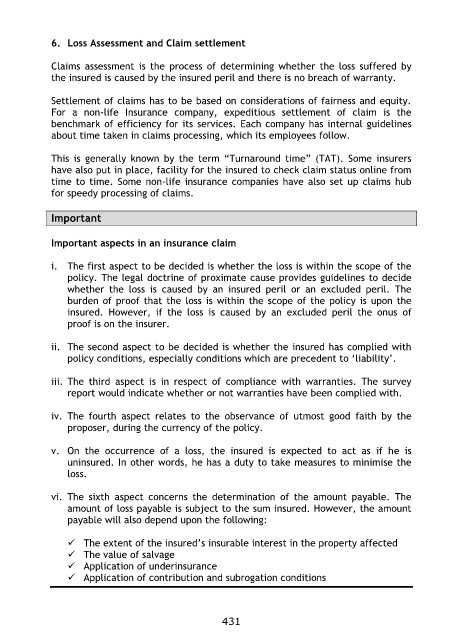Page 437 - IC38 GENERAL INSURANCE
P. 437
6. Loss Assessment and Claim settlement
Claims assessment is the process of determining whether the loss suffered by
the insured is caused by the insured peril and there is no breach of warranty.
Settlement of claims has to be based on considerations of fairness and equity.
For a non-life Insurance company, expeditious settlement of claim is the
benchmark of efficiency for its services. Each company has internal guidelines
about time taken in claims processing, which its employees follow.
This is generally known by the term “Turnaround time” (TAT). Some insurers
have also put in place, facility for the insured to check claim status online from
time to time. Some non-life insurance companies have also set up claims hub
for speedy processing of claims.
Important
Important aspects in an insurance claim
i. The first aspect to be decided is whether the loss is within the scope of the
policy. The legal doctrine of proximate cause provides guidelines to decide
whether the loss is caused by an insured peril or an excluded peril. The
burden of proof that the loss is within the scope of the policy is upon the
insured. However, if the loss is caused by an excluded peril the onus of
proof is on the insurer.
ii. The second aspect to be decided is whether the insured has complied with
policy conditions, especially conditions which are precedent to „liability‟.
iii. The third aspect is in respect of compliance with warranties. The survey
report would indicate whether or not warranties have been complied with.
iv. The fourth aspect relates to the observance of utmost good faith by the
proposer, during the currency of the policy.
v. On the occurrence of a loss, the insured is expected to act as if he is
uninsured. In other words, he has a duty to take measures to minimise the
loss.
vi. The sixth aspect concerns the determination of the amount payable. The
amount of loss payable is subject to the sum insured. However, the amount
payable will also depend upon the following:
The extent of the insured‟s insurable interest in the property affected
The value of salvage
Application of underinsurance
Application of contribution and subrogation conditions
431

